Telstra is now selling a 5G mobile broadband device that is capable of using the 5G millimetre waveband (mmWave) – even though the mmWave spectrum is so far only available in test locations.
Called the 5G Wi-Fi Pro, Telstra’s early foray into mmWave technology has a colour touch screen, gigabit ethernet, USB connections, and can support up to 30 devices on the next-gen Wi-Fi 6 standard.
Telstra is billing the $600 5G Wi-Fi Pro as a “future-proofed” device because of its ability to leverage a technology that hasn’t yet travelled far beyond the testing stage.
Telstra’s Executive of Product and Service Design, Andrew Stormont, said the 5G Wi-Fi Pro was a "huge leap in connectivity”.
“mmWave is going to be a big part of our 5G future and with the Telstra 5G Wi-Fi Pro we are offering customers a device that will be able to take advantage of the next iteration of 5G as soon as it arrives.”
Australia’s first mmWave spectrum will be the 26GHz band which ACMA is expected to auction next year.
Until then, customers forking out for the 5G Wi-Fi Pro can get a taste of mmWave at sites in Melbourne, Paramatta, and on the Gold Coast where Telstra is licensed to run high frequency 5G scientific trials.
Not quite full 5G yet
Telstra now has mid-band 5G switched on in 47 cities around Australia and boasts that around eight million Australians pass through its 5G network every day – but the speeds don’t look yet look like a massive next-gen leap.
According to a recent Open Signal survey, the average download speed on Telstra’s existing 5G network is 157Mbps.
This is still much faster than the average 4G speed of 48.3Mbps, although it’s a long way off the potential gigabit speeds that 5G is touted to offer.
The best performing provider measured by Open Signal was Verizon in the US which clocked an average speed of 506Mbps along its 5G network that exclusively uses mmWave signals.
Troubled rollout
With 5G getting closer to consumer use, the rollout from telcos has been met with ire from sections of the community who fear that the next-generation mobile technology is doing more harm than good.
The Byron Shire Council recently voted to suspend 5G development until it gets more assurances from Telstra and government that 5G does not pose a health risk.
Last year, the government started spending $9 million to promote 5G safety ahead of the technology rollout, complete with assurances from Australia's radiation regulator that 5G is safe.
Unfortunately, as the coronavirus spread around the globe, so did misinformation about the virus – including that the COVID-19 pandemic has been exacerbated by 5G towers.
These theories have been so pervasive that people in the UK, Canada, and New Zealand have been burning down phone towers.
Last week, Australian counterterrorism officers began investigating a phone tower fire in Melbourne for fear it could have been related to conspiracy theorists.










